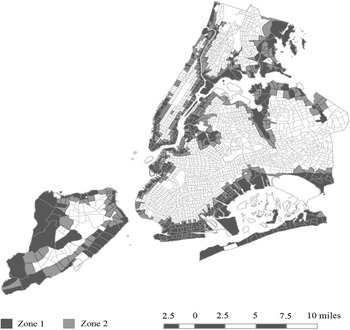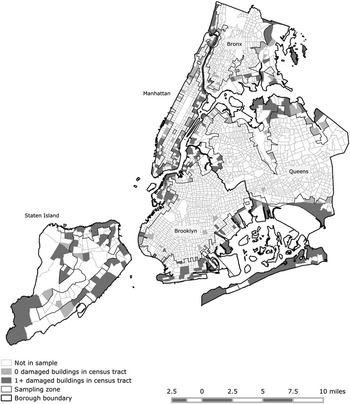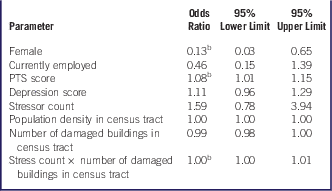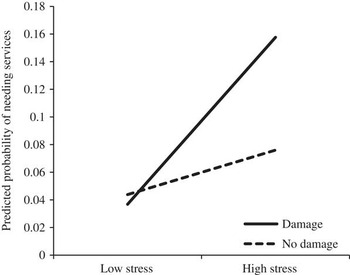Natural disasters killed an average of 106,654 people per year globally between 2003 and 2012,Reference Guha-Sapir, Hoyois and Below 1 and 13% to 19% of US adults have reported experiencing a natural disaster in their lifetime.Reference Galea, Nandi and Vlahov 2 Experiencing a natural disaster is considered a potentially traumatic event that may result in post-traumatic stress disorder (PTSD) or other mental health symptoms.Reference Weathers, Blake and Schnurr 3 Previous literature has demonstrated that mental health problems including both PTSD and depression are elevated compared to usual levels in the aftermath of natural disasters.Reference Neria, Nandi and Galea 4 - Reference Kessler, Galea and Gruber 7 Commensurately, perceived need for mental health services is also higher after these events.Reference Weisler, Barbee and Townsend 8 , Reference Pietrzak, Southwick and Tracy 9
Perceived need is a precursor to the use of mental health services, which are critical to address the burden of post-disaster psychological symptoms. However, evidence suggests that fewer than half of those who might benefit from mental health care actually receive it,Reference Wang, Aguilar-Gaxiola and Alonso 10 especially in the context of natural disasters where health care services are often interrupted.Reference Wang, Gruber and Powers 11 Furthermore, even when individuals do receive care, there is often a large temporal gap between the onset of symptoms and treatment,Reference Wang, Lane and Olfson 12 which could be attributed in part to a lack of perceived need. Accordingly, understanding the factors that drive perceived service need in the aftermath of disasters can be critical in mitigating post-disaster mental health problems.
Few studies have assessed predictors of perceived mental health need in a post-disaster context.Reference Pietrzak, Southwick and Tracy 9 A larger body of literatureReference Kessler, Galea and Gruber 7 , Reference Goldmann and Galea 13 , Reference Maguen, Neria and Conoscenti 14 has explored other post-disaster mental health indexes such as PTSD and depression and has implicated a broader array of individual-level factors that are associated with such indexes, such as preexisting mental health problems,Reference Goldmann and Galea 13 sex and other demographic characteristics,Reference Goldmann and Galea 13 and post-disaster stressors such as job loss.Reference Wang, Gruber and Powers 11 , Reference Maguen, Neria and Conoscenti 14
In addition to individual-level factors, post-disaster perceived need is likely to be influenced by characteristics of communities in which residents live. Prior studies have indicated that community-level factors influence indexes of post-disaster mental health. For example, residents of communities that have faced comparatively more damage have been shown to have higher risk of PTSDReference Frankenberg, Nobles and Sumantri 15 and negative affect.Reference Phifer and Norris 16 However, no studies to our knowledge have investigated community-level factors, including community-level exposures, as predictors of perceived need as an outcome. Additionally, it is possible that individual- and community-level factors have a joint influence on post-disaster mental health, such that the influence of an individual-level risk factor might depend on the extent to which the community as a whole is affected by the disaster.
The conservation of resources theoryReference Hobfoll 17 states that accumulation and retention of resources is critical in buffering the effects of stress. This framework provided by Hobfoll posits that people in general strive to gain, retain, and protect resources, and that stress occurs when there is actual or threatened loss of these resources. Hobfoll defines resources as objects, characteristics, or conditions that are valued by individuals. A hurricane is an example of an event that threatens and often includes actual loss of resources including housing, surrounding neighborhood infrastructure, income, or health.Reference Hobfoll 17 Therefore, using both the conservation of resources theory and previous literature on individual- and community-level influences on post-disaster mental health, we hypothesized that if one loses resources from both their community and their personal life through hurricane-related damage and stressors respectively, we would expect this person to have a worse outcome than if they experienced loss at only the community level or only the individual level.
In this vein, a handful of studies have explored interactions between individual- and community-level factors after disaster. Frankenberg and colleaguesReference Frankenberg, Nobles and Sumantri 15 found that the relationship between individual traumatic event exposure and post-traumatic stress reaction (PTSR) after the 2004 Indian Ocean tsunami was weaker in communities with more tsunami damage, not following with the conservation of resources theory. On the other hand, Ursano and colleaguesReference Wind and Komproe 18 , Reference Ursano, McKibben and Reissman 19 did not find a significant interaction between individual storm stressors and community storm damage when predicting probable PTSD after the 2004 hurricane season in Florida. No prior research of which we are aware, however, has considered how multilevel factors jointly predicted need for mental health services after these events.
In the current study, we aimed to see whether the conservation of resources theory would hold true in terms of a positive multiplicative interaction of individual- and community-level loss when predicting perceived need after Hurricane Sandy in our representative sample of survivors, whether we would find no significant interaction similar to Ursano and colleagues, or whether we would find an interaction in a different direction similar to Frankenberg and colleagues.
Hurricane Sandy was a post-tropical cyclone that struck the New York metropolitan area in October 2012, resulting in over 100 deaths and over $50 billion in damages. 20 , 21 New York City alone saw about $19 billion in damages and 43 deaths.Reference Toro 22 , Reference Goldstein, Peterson and Zarrilli 23 In hitting New York City, a city with tremendous inter-individual heterogeneity among residents, Hurricane Sandy represents an opportunity to assess how individual and collectively experienced events jointly drive perceived need in the months following the storm.
METHODS
Study Design and Setting
This study used a cross-sectional design with participant data gathered from a telephone interview (approximately 25 minutes long) of New York City residents from December 2013 to March 2014. The structured questionnaire was available in both English and Spanish and was administered by trained interviewers. Oral consent was obtained from all participants, and the study protocol was approved by the institutional review boards of Columbia University and Boston University.
Selection of Participants
Participants were sampled on the basis of the Operational Inundation Area identified by the Federal Emergency Management Agency Modeling Task Force (FEMA MOTF). 24 We created two “zones” based on estimated flood levels. The first zone targeted census tracts in which approximately 50% or more of the area was inundated with floodwater, and the second zone targeted tracts in which some, but less than 50%, of the area was inundated, or tracts that were adjacent to the tracts from zone 1 (Figure 1).

Figure 1 Sampling Frame in New York City Based on Federal Emergency Management Agency Analysis of Inundated Areas.
Adults 18 years of age or older with landline or cellular telephones living in these areas were then sampled in 2 ways. Half were recruited via address-based sampling in which households were recruited by mail and telephone and one adult was randomly selected from each household to participate. The remaining half were recruited through random-digit dialing of cellular phones, in which geographic screening determined whether potential participants were living in the sampling zones at the time of the hurricane. Our final sample of 500 individuals represented an overall response rate of 35%.
Among the 500 participants, 47 did not disclose their addresses at the time of the hurricane, which rendered us unable to collect geographic contextual-level data on them. Additionally, 35 respondents were excluded owing to missing data, resulting in a final analytic sample of 418.
Primary Outcome
The main outcome we modeled was based on the following survey question: “Since Hurricane Sandy, have you felt a need for any counseling or treatment for your emotions, nerves, or mental health?” The possible answers were “yes” or “no,” and responses were dummy coded as 1 and 0, respectively.
Explanatory Variables
Individual-Level Variables
Employment status, sex, depression, and post-traumatic stress (PTS) were included in our models because of associations noted in previous literature with perceived service need.Reference Goldmann and Galea 13 Employment status was gathered by asking participants whether they were employed on a job for pay during the past week. If they were, employment status was coded as 1; otherwise, it was coded as 0. Sex was coded as 1 for female, 0 for male.
Depression score was defined as the sum of all 9 items on the Patient Health Questionnaire (PHQ-9),Reference Kroenke, Spitzer and Williams 25 each of which range from 0 (not at all) to 3 (nearly every day) for how often the participant had the symptom in the past 30 days. Cronbach’s alpha for the PHQ-9 in this sample was 0.88, showing high reliability.
A PTS score was defined as the sum of the 20 items on the PTSD Checklist (PCL)Reference Weathers, Litz and Keane 26 from the Diagnostic and Statistical Manual of Mental Disorders, 5th edition. 27 Symptoms were asked about in reference to the past 30 days and in reference to Hurricane Sandy, and each ranged from 0 (not at all) to 4 (extremely). Cronbach’s alpha for the PCL-5 in this sample was 0.93, showing excellent reliability.
Hurricane-related stressors were defined as (1) being displaced from home for over 1 week, (2) reporting a loss of resources (electricity, running water, or heat) for over 1 week, (3) reporting at least some damage to home, and (4) experiencing household income decline due to Sandy. These stressors have been used in studies after other disaster hurricane contexts.Reference Tracy, Norris and Galea 28 Participants indicated (yes/no) whether they experienced each stressor, and a sum of affirmative responses was included.
Community-Level Variables
Number of damaged buildings was gathered from a publicly available point shape file from FEMA MOTF, 29 in which each point represented a damaged building based on geographical coordinates. This information was aggregated at the census-tract level in the geographic information system (GIS) program QGIS. 30
Because the impact of damaged buildings could depend in part on the population of each area, we also included a measure of population density in each tract. Population was taken from the 2007-2011 American Community Survey (ACS) 5-year estimate, retrieved from the Infoshare database, 31 and divided by the area of each census tract in square kilometers, calculated by using QGIS.
Statistical Analysis
First, individuals were assigned statistical weights to adjust for disproportionate sampling probabilities owing to the dual-frame sampling design (both cell phone- and address-based) and to match the race/ethnicity, marital status, educational attainment, and age group by sex of the target sampling area, using the 2007-2011 American Community Survey 5-year estimates. 32
Second, the SAS 33 procedure Proc Genmod was used to model a multilevel binomial logistic regression with service need as the outcome. Explanatory variables were iteratively included as we tested main effects. Then, a cross-level interaction between hurricane-related stressors and number of damaged buildings was tested. Stratified models along the median split of number of damaged buildings (0 vs. 1 or more) were then conducted, including stressor count as a main effect in the model.
Finally, we graphed predicted probabilities generated by the final interaction model, stratified by the median split for both variables of interest (0 vs. 1 or more for both) and controlling for all other variables in the model.
RESULTS
Table 1 shows the prevalence of all variables used in our final model. Our sample consisted of just over half females, with half currently employed. The mean PTS and depression scores were 7.25 (SD=11.0) and 3.26 (SD=4.9), respectively, and over a third of participants (37.2%) experienced one or more stressors. Forty respondents (7.9%) reported needing mental health services. At the community level, the average population density per tract was 19,338.3 people per square kilometer, and 45.7% of census tracts had at least one damaged building. Figure 2 maps which census tracts had 0 and which had 1 or more damaged buildings.

Figure 2 Number of Damaged Buildings by Census Tract for Those Represented by Participants.
Table 1 Prevalence of Individual-Level and Community-Level Variables in 418 Hurricane Sandy Survivors, Representing 293 Census TractsFootnote a

a Abbreviation: PTS, post-traumatic stress.
Table 2 presents odds ratios (ORs) and 95% confidence intervals (CIs) for our multivariable multilevel model predicting service need showing only main effects. Female sex was associated with an 80% lower odds of reporting service need (adjusted odds ratio [AOR]=0.20; 95% CI: 0.05-0.75). Each unit increase on the PCL scale was associated with a 7% higher odds of service need (PTS AOR=1.07; 95% CI: 1.02-1.13), and each additional hurricane-related stressor was associated with a 79% higher odds of service need (AOR=1.79; 95% CI: 1.00-3.15). The main effect for the number of damaged buildings in each census tract was not statistically significant.
Table 2 Multilevel Binomial Logistic Regression Model Predicting Perceived Service Need in 418 Hurricane Sandy SurvivorsFootnote a

a Abbreviation: PTS, post-traumatic stress.
b P<0.05.
Table 3 presents ORs and 95% CIs for the same model as in Table 2 but with the statistical interaction term included. Being female remained protective of reporting service need (AOR=0.13; 95% CI: 0.03-0.65), and individual-level PTS remained predictive (AOR=1.08; 95% CI: 1.01-1.15). The multiplicative cross-level interaction between hurricane-related stressors and number of damaged buildings was also significantly associated with service need (AOR=1.00; 95% CI: 1.00-1.01, P=0.04), whereas each individual main effect was not.
Table 3 Multilevel Binomial Logistic Regression Model Predicting Perceived Service Need in 418 Hurricane Sandy Survivors, With Interaction TermFootnote a

a Abbreviation: PTS, post-traumatic stress.
b P<0.05.
Table 4 shows the same model as in Tables 2 and 3 but stratified by number of damaged buildings (0 vs. 1 or more), with only the main effect of hurricane-related stressors included in each model, in order to examine effect measure modification on the relative scale. In communities with one or more damaged buildings, the effect of stressors on perceived need was significant (AOR=2.56; 95% CI: 1.58-4.16). In contrast, the effect in communities with no damaged buildings was nonsignificant (AOR=2.16; 95% CI: 0.58-8.10). PTS was also only significant among those in damaged communities (AOR=1.06, 95% CI: 1.01-1.11), whereas sex remained significant in both.
Table 4 Multilevel Binomial Logistic Regression Models Predicting Perceived Service Need in 418 Hurricane Sandy Survivors, Stratified by Median Number of Damaged BuildingsFootnote a

a Abbreviation: PTS, post-traumatic stress.
b P<0.05.
Figure 3 shows further investigation into this interaction by graphing predicted probabilities of the outcome based on our final interaction model. Respondents with no stressors had about the same probability of needing services (0.04) regardless of the damage in their census tract. On the other hand, respondents with both stressors and damage saw double the probability (0.16) compared to those with stressors but no damage (0.08) (and 4 times the probability of those with no stressors). The difference in slopes of the 2 groups illustrates the stronger relationship between stressors and service need among those in damaged tracts compared to undamaged tracts.

Figure 3 Predicted Probability of Perceived Service Need by Number of Damaged Buildings and Stressor Count in 418 Hurricane Sandy Survivors.
DISCUSSION
In a representative study of Hurricane Sandy survivors in New York City, we found that women were significantly less likely to report perceived need since the hurricane and that both PTS and hurricane-related stressors were significantly associated with higher odds of perceived service need since the hurricane. Most importantly, community-level damage was not significantly associated with perceived service need by itself but rather only in combination with individual stressor count. Persons who experienced individual stressors and lived in the most damaged communities were most likely to report perceived need compared with all other groups.
Our results were simultaneously in alignment with and inconsistent with a prior study of perceived need in the aftermath of a hurricane conducted by Pietrzak and colleagues.Reference Pietrzak, Southwick and Tracy 9 As in our analysis, their study of Hurricane Ike survivors found PTS to be associated with perceived service need.
However, in contrast with our findings, Pietrzak and colleagues found that hurricane-related experiences and female sex were not associated with post-hurricane perceived service need. These departures may be explained by the facts that Pietrzak and colleagues included potentially traumatic events in their list of hurricane experiences, whereas ours included stressors only, and a larger proportion of their sample endorsed perceived need (27.2% vs. our 7.9%), likely because of a scale of 4 questions as opposed to 1, as well as a more destructive hurricane. Other differences in their study included using a dichotomous measure of PTSD and specifying that it be present prior to the hurricane.
Our findings also differed from Frankenberg et al’sReference Frankenberg, Nobles and Sumantri 15 study in the aftermath of the Indonesian tsunami in that we did not find community-level damage by itself to be associated with our mental-health-related outcome, and our interaction between community-level damage and individual-level exposure was in the opposite direction. Specifically, whereas we found that the combination of community-level damage and individual stressors increased the odds of perceived need, Frankenberg and colleagues found that the relationship between individual exposure and PTSR was weaker in communities with more damage. We attribute this difference largely to the disaster context, because the tsunami had more widespread community damage in general; the difference in outcomes (PTSR vs. perceived need); and the fact that we examined stressors as the individual exposure whereas Frankenberg and colleagues examined traumatic events.
One mechanism accounting for the effect measure modification and interactive effect we found could be that community-level damage served as a visual reminder of personal stressors. This type of visual trigger has been shown to occur among survivors of traumatic events,Reference Ehlers, Hackmann and Steil 34 and it is possible that community damage in this case multiplied the effect of the stressors participants had experienced. Alternatively, surrounding damage could have caused worry that there was not enough help to go around and that there was competition for resources, resulting in perceived need among those who might have needed these types of resources most due to the stressors they incurred. Whether this kind of competition is real or imagined, it has been noted as a possibility after natural disasters to cause social strain in large cities.Reference Tipson 35
Our finding lends itself to the conservation of resources theory, which posits that both personal and social resources buffer against potential negative outcomes of stressful events.Reference Hobfoll 17 Community damage and exposure to individual-level stressors both represent the loss of resources at different levels, the multiplication of which was associated with need in our sample. Furthermore, community damage may result in more restricted access to social support and other resources that might usually buffer a person’s stress.
Limitations
A few cautions must be borne in mind when interpreting these findings. First, although our outcome question was asked in relation to service need since the hurricane, it was not asked specifically in relation to emotions or problems that occurred because of Hurricane Sandy. Perceived need was asked about in this way for 3 reasons: (1) to capture a broader picture of health needs, (2) because respondents may not be able to identify exactly what triggered their symptoms, and (3) because we designed the survey to be 20 to 25 minutes to decrease responder burden and we were thus unable to ask more specific questions about the timing and nature of their need. Therefore, it is possible that the problems individuals were experiencing were unrelated to the hurricane or existed before the storm. Related, we did not ask specifically for the type of mental health need (eg, need for therapy vs. need for medication, etc), which may have influenced both the prevalence of and potentially the explanatory variables of our outcome.
Like any population-based survey study, there is potential concern about nonresponse bias. However, we reduced the possibility of bias by using both address-based and cell phone-based sampling as well as by weighting respondents to match area-wide demographics. Lastly, our results may not be generalizable to Hurricane Sandy survivors living in geographic areas outside of our study zone or to the aftermath of other natural disasters.
CONCLUSIONS
Despite these cautions, our findings support the conservation of resources theory. The accumulation and retention of resources is critical in buffering the effects of stress, and natural disasters have the potential to disrupt both community structures and individuals’ homes and jobs, affecting a spectrum of resources. Reducing exposure to individual-level stressors in communities with more damage could help to reduce the overall mental health burden after disasters. This is especially timely as the incidence of climate-related natural disasters is increasing across the globeReference Field, Barros and Stocker 36 and could inform potential evidence-based interventions.Reference North and Pfefferbaum 37 Future analyses may consider how different types of stressors or different measures of damage may illuminate these findings.
Funding
DHHS grants HITEP130003-01-00 and HITEP140015-01-00. OG was funded by the German Research Foundation (DFG, GR 4302/1-1).









